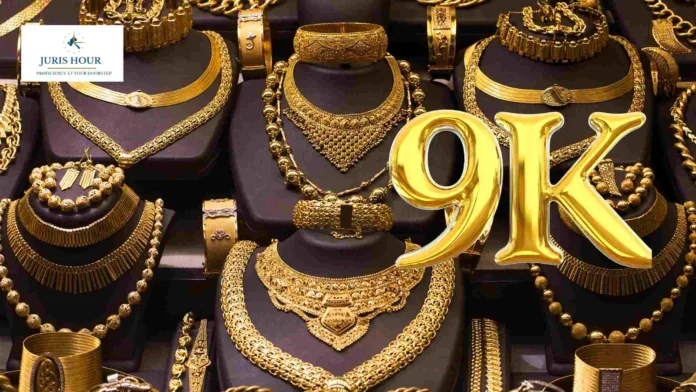In a move aimed at making gold more affordable for first-time and budget buyers ahead of the festive and wedding season, the Ministry of Consumer Affairs (through the Bureau of Indian Standards, BIS) has approved hallmarking for 9-karat (9K) gold, effective July 2025. Until now, hallmarking covered 14K, 18K, 20K, 22K, 23K and 24K categories; 9K (minimum fineness 375 parts per thousand) is now added to the list.
What this really means (and why people are saying “gold from ₹10,000”)
The government has not fixed a minimum purchase price for gold. Instead, by letting lower-karat gold (9K) enter the hallmarking net, BIS has opened the door for lighter, smaller, and cheaper hallmarked jewellery—think tiny pendants, studs or charms—often landing in the ~₹10,000 range once weight, making charges and GST are factored in. The actual bill depends on:
- Weight & purity (karat) of the piece
- Making charges (typically attract 5% GST)
- Gold value (attracts 3% GST)
The change comes as domestic gold prices have hovered near record territory—approaching ₹1 lakh per 10g (24K)earlier this year—pushing many buyers toward lower-karat jewellery.
The rule at a glance
- From July 2025, BIS will hallmark 9K gold along with 14K, 18K, 20K, 22K, 23K and 24K categories.
- Hallmarking expansion is continuing: in the 5th phase (Order dated 31 July 2025), BIS added 12 more districts to mandatory hallmarking coverage.
- HUID (Hallmark Unique Identification) is mandatory: selling hallmarked gold without a 6-digit alphanumeric HUID has been prohibited since March 31, 2023. Buyers can verify HUID instantly via the BIS CARE app.
Why 9K matters for consumers
- Lower entry price: 9K contains 37.5% gold (fineness “375”), making small, hallmarked pieces more budget-friendly for gifts during Navratri, Diwali, and wedding season.
- Trust & transparency: Hallmarking certifies purity and ties each piece to a traceable HUID, reducing the risk of adulteration.
- Wider choice: Retailers can legally offer a broader range of hallmarked categories, from 9K up to 24K, across more districts as rollout expands.
What to check at the counter (quick checklist)
- Hallmark details on the piece:
- BIS logo, purity mark (e.g., 375 for 9K, 585 for 14K, 750 for 18K, 916 for 22K), and the HUID.
- Use the BIS CARE app → “Verify HUID” to confirm the article’s purity, jeweller registration and hallmarking centre.
- Invoice clarity: weight, karat, making charges (which draw 5% GST) and gold value (which draws 3% GST) shown separately.
- Buy from BIS-registered jewellers only; recent enforcement actions show BIS is cracking down on misuse of hallmarks and missing HUIDs.
Karats 101 (India)
- 9K (375), 14K (585), 18K (750), 20K (833), 22K (916), 23K (958), 24K (999/995) are the hallmarkable grades now in scope after the 9K addition. Lower karat = more alloy = lower price and generally higher durability, but paler colour vs 22K/24K.
What jewellers say this could change
Trade trackers expect entry-level gifting (kids’ jewellery, daily-wear studs, minimalist chains/charms) to expand, particularly in urban and semi-urban markets, with hallmark assurance easing buyer hesitation around lower-karat pieces. (Industry coverage: ET/Business Standard.)
Myth vs Fact
- Myth: “Government has set a new scheme to sell gold at ₹10,000.”
Fact: No price cap or scheme. The policy adds 9K to hallmarking, enabling smaller, lighter pieces that can cost around ₹10,000, depending on weight, making charges and taxes.
Bottom line
For festive-season shoppers—Diwali, Navratri, and wedding buys—the government’s move to hallmark 9K gold broadens trusted, lower-budget options. Just remember: verify the HUID on the BIS CARE app, understand the karat you’re buying, and check making charges and GST on your bill before you swipe.
Read More: Thailand Plans Free Domestic Flights for Foreign Tourists to Boost Travel Beyond Hotspots

